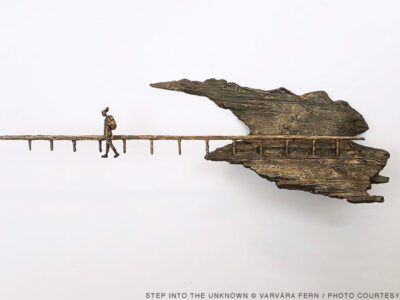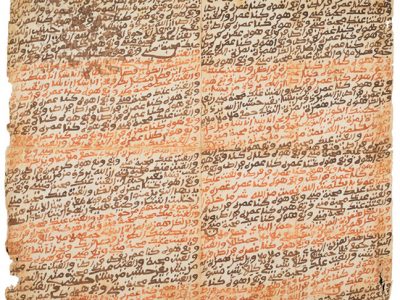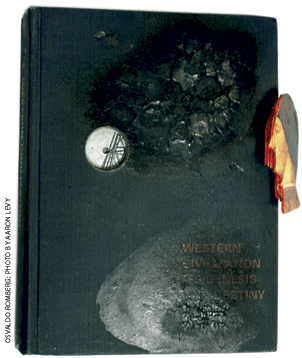
It borders on the subversive, this retrospective exhibition by Osvaldo Romberg, mounted in the belly of Van Pelt-Dietrich Library. At first glance, in fact, The Library is Burning: Text, Image, Object seems to lay waste to the whole landscape of books: A 16th-century prayer book has makeshift plastic mannequins cavorting on its cover; a book about modern art has been charred and sealed, with a bolt driven through it; the King James Bible has been sliced into sections and punctuated with a fish-head and nails; Jorge Luis Borges’ short story “The Aleph” has been transformed into a fold-out book in which seemingly random words have been underlined or highlighted or spiced with images of famous paintings taped to its acetate pages.
But the mutilation, if that is the word, has been carried out in a way that is both iconoclastic and strangely respectful. The barbarian at the gate is an erudite one. His work stimulates the eye and the mind, but it isn’t trying to shock for the sake of shocking. And it certainly isn’t trying to entertain.
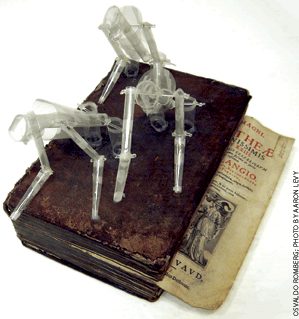
“I think the late pieces include a kind of allegory to the end of reading,” says Romberg in his thick Argentinean accent. “The idea of the book as an object, which you can open to any page you want, is in a way disappearing for the younger generation. Also, the library represents the Library of Alexandria—the idea that when the knowledge is disappearing, the culture is disappearing.”
Romberg is a senior curator at the Slought Foundation in University City [“All Things Ornamental,” Nov/Dec 2004] and a professor of art at the Pennsylvania Academy of the Fine Arts. The exhibition covers more than four decades of his work, starting with early woodcuts that illustrated the works of poets in his native Buenos Aires in the 1960s. (He came to Philadelphia 14 years ago after spending time in Israel, but he still lives and works in New York and Isla Grande, Brazil, and has exhibited all over the world.)
In addition to a wary fascination with technology, many of Romberg’s pieces make use of objects from the natural world: seashells, beetles, a fish-head. Books of poetry have evolved into a da Vinci-like makeshift bird. The evolution of the artist offers a parallel to the art of evolution.
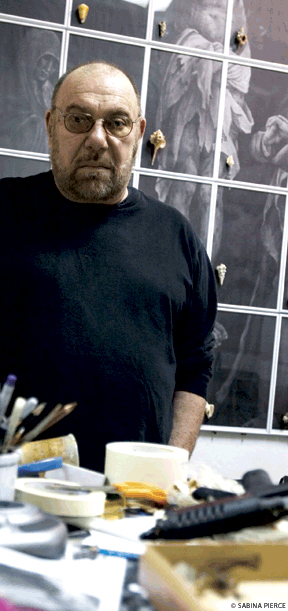
“A long time ago I realized that for me, art belongs to the natural sciences, not the social sciences,” he says. “We are really monkeys without hair—animals.” At times Romberg creates a psychic clash of seemingly opposing forces within a single piece, such as the 1996 “Dilemma Between Faith and Knowledge.” A prayer book and a long, corkscrew-shaped seashell have been inserted into a cavity in an old, sealed encyclopedia; a tiny cut-out of El Greco’s “Burial of Count Orgaz” adorns a spot where the side cover meets the spine.
Yet Romberg insists that he doesn’t deliberately choose the individual objects of nature or images from art-history books. “They pick out me,” he says. “I don’t pick out them. Suddenly an image says to me, ‘I should be there.’”
—S.H.
The Library Is Burning: Text, Image, Object: 1963-2005 runs through June 7 at the Kamin Gallery of Van Pelt-Dietrich Library.



